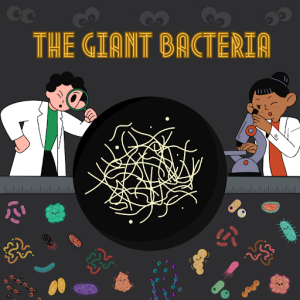Thiomargarita magnifica – A giant bacteria in a microscopic world
By Sneha Das, C2ST Intern, University of Illinois Urbana-Champaign
You may remember bacteria as teeny-tiny organisms seen under a microscope from biology lessons in school. In this blog, however, I will introduce you to a giant bacteria visible to the naked eye. Thiomargarita magnifica, the world’s largest bacteria, is about a centimeter long – roughly the length of a human eyelash. Its species name “magnifica” is inspired by the Latin word ‘magnus’ meaning big, and the French word ‘magnifique’ meaning gorgeous.
T. magnifica was first discovered in the Caribbean mangroves of Guadeloupe in 2009. It looked like a bunch of small threads floating on leaf debris – each thread too long to qualify as a single bacterial cell. After years of careful examination, scientists finally reported the discovery of this bacterial titan in June 2022. Jean-Marie Volland, a scientist who studied T. magnifica, describes it as 5,000 times bigger than an average bacteria which, to put it in perspective, would be like a human encountering another human as tall as Mount Everest.

How is T. magnifica different from a typical bacteria? Well, size is the obvious one, but several other characteristics make it unique and challenge our current understanding of the bacterial world.
DNA contains information that gives an organism life and distinctive characteristics. Based on the location of DNA inside the cell, organisms can be prokaryotes (simple cells that lack a nucleus) like bacteria or eukaryotes (cells with a nucleus and other membrane-bound structures) like humans. In most bacteria, DNA floats freely in a jellylike liquid called cytoplasm, whereas in humans the DNA is housed in a membrane-bound compartment called the nucleus.
Unlike other bacteria, T. magnifica stores its DNA inside compartments similar to humans. These compartments were named “pepins” after seeds in a fruit. While a typical bacteria like E. coli has only one copy of its DNA, T. magnifica has about half a million DNA copies spread throughout its cell body. The number of genes or information-containing units in its DNA is also three times more than an average bacteria. The location, size, and complexity of DNA make T. magnifica exceptional in the bacterial world.
In addition to its unique DNA, T. magnifica displays a fascinating adaptation for feeding. One way bacteria get food is through a process called diffusion where molecules move from higher concentration to lower concentration. Nutrients diffuse from outside the cell, cross the cell membrane (outer boundary of the cell) and enter the cytoplasm where it is used by bacteria as fuel for growth. To get food quickly by diffusion and grow fast, the size of a bacterial cell needs to be very small.
How does a giant bacterium like T. magnifica get its food by diffusion? The answer lies in a special fluid-filled compartment called the vacuole. Imagine that a T. magnifica cell is a giant water-filled balloon where the balloon surface is the cell membrane and the water inside it is the cytoplasm. In this case, diffusion will be slow since the volume of water is significant. Now, if we put an inflated balloon inside the first balloon, the water between the two balloons will be much less in volume as it pushes to the edges. T. magnifica cells have a large vacuole inside them, and the cytoplasm fills the thin space between the cell membrane and the vacuole. This special feature increases diffusion and allows T. magnifica to get food rapidly and maintain its gigantic size.
The discovery of T. magnifica is a fascinating example of diversity in the microbial world. It is a common notion that microorganisms are small and simple, but this bacterial giant proves that life at a single-cell level is indeed intricate and complex.
Sources: